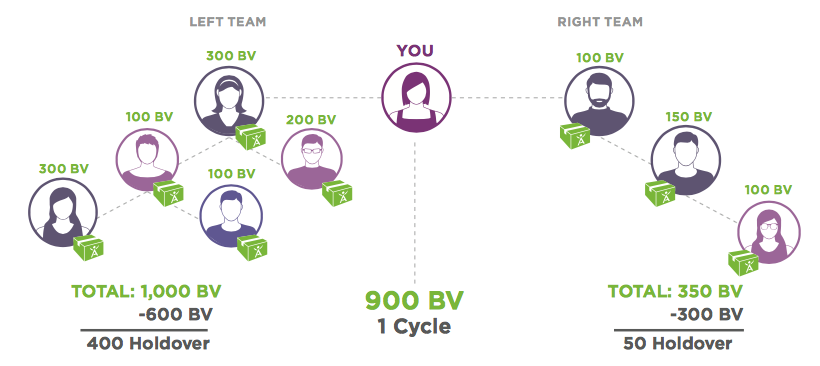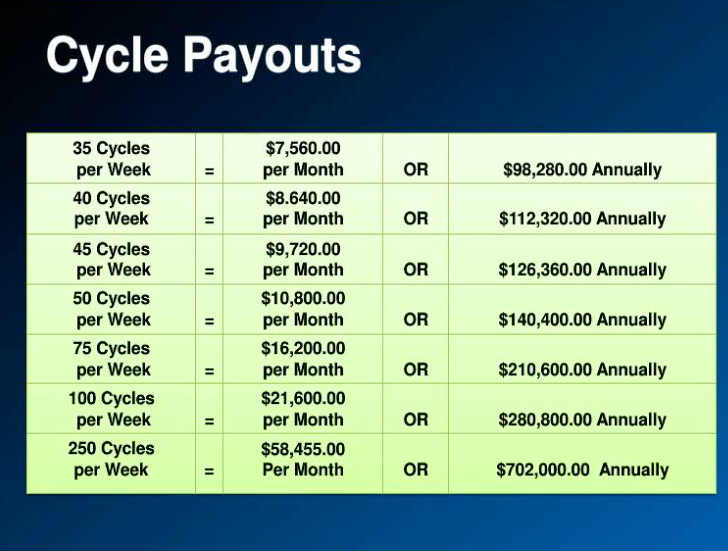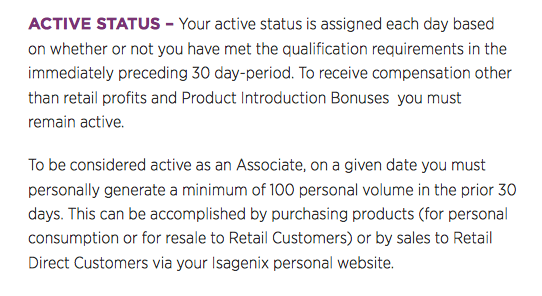How much money can you earn with MLM Isagenix?
What’s it REALLY like as an Isagenix rep? And how much money can you really earn with Isagenix? One former rep tells her story.
Regular readers of our site will know we’ve investigated a number of MLMs over the past few months.
We’ve examined income disclosure statements to reveal how little money reps make working for an MLM (in fact, as we discovered, an average of 99.6% of reps actually lose money), and looked at some of the underhand tactics MLM employ to recruit, including the car bonus and fake job ads.
As our research progressed we began to see more clearly how MLMs work, and the many tricks they employ to recruit and retain people. But up to now we haven’t shared a rep’s story.
How one woman spent over £1,200 as an Isagenix rep
However, we were recently contacted by a woman who used to sell Isagenix, an MLM company that sells dietary supplements and personal care products. This woman’s story is fairly typical of the experiences we hear from former reps.
As you’ll discover, it’s starkly at odds with the recruitment pitch you’ll hear from MLM reps who want you to join their downline.
MLMs often do their best to prevent and suppress any negative experiences or opinions, and we think it’s important that the truth for many of the women (and men) who join these companies is told.
So we thought it worthwhile to share this woman’s experience with Isagenix with you. (As she was recruited by someone she knows, and has already received abuse for leaving, she understandably wishes to remain anonymous.) We share her story below, followed by some of our own research into Isagenix, and the money reps are earning with them.
“I joined Isagenix in May 2017”
Isagenix was due to launch in the UK later in the month I joined. I was introduced by a friend who had previously been with another MLM where she had built a team and purported to earn between £7-8k each month.
This person knew the business leader from another MLM from who had jumped-ship to lead the UK launch of Isagenix. The UK leader had built a six-figure business with the other MLM and taken a very analytical approach to the opportunity launch an MLM in the UK and be the ‘gateway’ to Europe.
The pitch to us was that being in at the start gave you unprecedented opportunity to build a strong team/network, and the international aspect only enhanced that. As I have lived in several European countries I have both the network and language skills that would be advantageous.
“The introductory package was £500”
There was no ‘cost’ to joining Isagenix, but you had to recruit two people and buy product every month to maintain a ‘points’ balance to maintain your rights to any commissions.
The introductory package was £500 (for one month), and you were advised to recruit your spouse to get started and manage both accounts yourself. The smallest possible order to maintain the required points to just keep yourself at that entry level was over £150 per month (so over £300 once you had yours and your spouse’s orders in).
You were encouraged to consume and ‘live’ the product yourself. The sales pitch was to ‘eat your overheads’.
The support promised sounded exceptional; weekly team calls, webinars hosted by HQ in the US where we would be taught about the nutritional content and new developments in the business. These were really over the top on enthusiasm and very low on scientific content.
“The Facebook groups were scary places”
In reality the webinars were sales pitches that waxed lyrical about the wonder product and the groundbreaking results you can achieve. They were very careful not to bill the products as weight loss, but rather a health enhancing lifestyle. As if anyone wants a life where they live off shakes!
There was also a range of supporting Facebook groups that were pretty scary places. People would discuss their sales practices, ask advice on how to get someone to join up, and post almost daily about how amazing their life was with this product in it.
It was cult like. No one questioned anything or was willing to even consider it wasn’t right for absolutely all the people in their lives. I found the Facebook groups really difficult to read, and quite brain-washing.
“We were told to comment on strangers’ Facebook posts”
There was one lady who had done quite well early on and was making a side-income teaching other members how to build sales using social media. Her advice was to comment on total stranger’s posts things like “I love your dress, where is it from? Since I lost all the weight I’m getting to buy a whole new wardrobe and this would just be perfect!”
It was frightening how many people would respond to the comment asking her how she lost the weight…. Since the product had only launched in the UK a month or so prior, there is no way it could have been as a result of that. This was never mentioned.
I quickly became sceptical of the claims, and did not attempt to recruit more people for this reason. From the sales I had made I covered my overheads, but nothing more, for the summer.
“You had to pay £5.99 a month to get paid”
A few months after the launch they changed how you would get paid. You had to sign up to their own ‘online wallet’ which they charged you £5.99 a month for. The products were billed in USD, with shipping as extra, and the exchange rate used to pay commission was different to that used to charge for the products.
All round a lose-lose for the consultants.
The final straw was when someone posted that their client had come out in hives and had been vomiting for three days since starting the shakes. The advice that came back was that it was ‘probably just the toxins coming out’. For me, the cult-like behaviour, constant need to recruit/sell/eat the product was just too oppressive.
Other posts were of people who wanted to join up but didn’t have the money to buy the first pack. Other members were encouraging them to take out loans, remortgage, borrow from friends, and even go to a pay-day loans company as they would ‘more than make their money back’ next month.
“The Facebook groups were awful when they found out I was leaving”
I cancelled my membership in August, but the next shipment (not due for another 14 days) was processed the day I cancelled, meaning I was charged.
The cancellation itself was a laborious process involving filling in forms, printing, signing, scanning, posting… to sign up all you need is a credit card and a tick in an online box! To return the unwanted product I had to return it via courier, the cost of which was around £30.
The Facebook groups were pretty awful once they found out you were leaving, each person’s up and down line is visible to others within it so it’s evident when someone leaves.
The parent company also emails you to tell you if anyone in your downline cancels and order or leaves, and calculates the commission you have lost through their action. Pretty divisive! Some of the members of the Facebook group trolled my personal account and left some fairly crass posts.
“I still have about £300 of product at home”
In total I think I spent nearly £1.2k in four months. I made about £450 in commission during that time. I have about £300 of product sitting around staring at me and have either used or given away the rest with a warning not to get sucked in, like I did.
Being recruited by a friend or family member really damages the relationship when you or they want to leave, or it just doesn’t work out for them. Your choices directly affect your friend’s income which changes the dynamic of your relationship with them.
This friend is now largely avoided by so many people with whom she used to be close. When she invites us round for drinks we never know if that’s what it is or if we’re going to be asked to ‘sample’ some new things. This is how it is and it just isn’t for me.
My friends are really important to me; I don’t see them as collateral to be leveraged for my own profit. I’m glad I did it because now I know what’s on the other side I won’t every be tempted again.
MLMs cost you money and damage relationships
This is just one woman’s story, but we’ve heard it dozens of times from reps we’ve spoken to who have seen the truth and left. Their time in an MLM often cost them money and damaged their relationships, just like this woman experienced.
Indeed, we believe that the way many MLMs operate are similar to cults and abusive partners. The business model appears to be built on recruiting people who will almost inevitably lose money – and bullying and coercing them into collusion and silence, using techniques like gaslighting. This is why we campaign so passionately against it.
What do other people say about Isagenix?
So how typical is this former rep’s experience with Isagenix? According to The Sydney Morning Herald, it seems to be fairly typical:
“While Sophia said she wasn’t interested in selling, she became concerned when she was added to a couple of closed Facebook groups – one offering ‘support’ and one for sales and marketing.
It was in these groups she says she witnessed firsthand the level of obsession people have with the products. “As every person who is signed up then has their own business, the person at the top is very keen to get everyone below them selling, because that money flows upwards.”
As a result she says the groups were full of salespeople doling out health advice with no qualifications. From pregnant or breastfeeding women complaining about hunger and being encouraged to persevere, to another participant dropping down from an already low body weight by another nine kilos and being cheered on by the group.
“At what point do ethics come into the sales and marketing? These people are selling ‘health’ products without any kind of health or nutritional knowledge. It struck me as dangerous,” she says.
However, she says any criticism falls on deaf ears within these groups. “It’s impossible to say anything negative about Isagenix to the ‘Clan’ because they’re all so obsessively patriotic to it, there’s almost no point in bringing things up.””
Like many MLMs, it appears you’re encouraged to sell as much as possible, so your upline can benefit. Reps are happy to make all kinds of wild claims to make sales, and are discouraged from expressing any opinion other than the relentlessly positive party line.
And just like other MLMs, the financial reality for most Isagenix reps isn’t as promising as they may believe:
“Despite the shiny, happy people in the promotional material making up to $171k a month, the harsher financial reality is that the majority of members who ‘share’ the product with family and friends will make “less than $500 a year”.”
This personal experience of the daughter of a former Isagenix rep on the Anti-MLM Coalition highlights some of the knock-on impact on family members:
“My siblings were encouraged to also drink the shakes to help them stay healthy “because of all the nutrients.” When we were hungry we were told to “drink a shake” instead of actual solid food (my younger brother was only ten at the time, it couldn’t have been healthy for him). She also recommended my brother take the same tea I did to help his (then-undiagnosed) attention deficit hyperactivity disorder (ADHD) but he hated it, so she never pushed it.
The time my Mum was part of the MLM caused my body confidence to hit it’s lowest point – Mum would constantly pressure me to drink the shakes, always telling me it was “to be healthy.” I was only fifteen at the time; being pressured to drink weight loss shakes (not that my Mum believed that they were for weight loss), well, it made me believe that my Mum thought of me as overweight, when I truly wasn’t.”
How much money can you earn with Isagenix?
Like many MLMs, Isagenix seem to make it difficult to work out exactly how much money you can earn with them. Their compensation plan is so complex you’d need a degree in MLM-speak to fathom it. Here’s just one of the many illustrations from their compensation plan:

While they don’t make any promises of income, like many MLMs they make it seem fairly simple and possible to earn good money:

But what are reps actually earning? To work it out, we managed to find a copy of their 2015 income disclosure statement, and the numbers are familiarly depressing.
The rep hierarchy in Isagenix looks like this:
- 82.5% are Product Users who apparently only want to use the products without selling.
- 12% are Product Sharers whose average annual income (before expenses) was $147.
- 5.4% are Business Builders whose annual income was over $500 before expenses.
Of the Business Builders, 43% earned an average income of $702, and 42% earned an average of 2,101 a year – all before expenses.
So only the top 3% of the top 5.4% of all Isagenix reps earned over an average of $34,362 a year before expenses. And less than 1% of the top 5.4% earned an average annual income of $68,690 before expenses.
These are pretty appalling odds, especially when Isagenix state that it takes a “significant commitment” to earn an income with them:
“The “business builder” category represents those who have made a signicant commitment to build a part-time or a full-time business selling Isagenix products and who have earned at least $500 in the previous year, either in commissions and bonuses or through retail sales.”
So Isagenix admit that there are reps who have made a “significant commitment” to build a business that earned them as little as $42 a month, before expenses.
We don’t know about you, but that doesn’t sound like an attractive ‘business opportunity’ to us.
“We’ve got a cash cow here”
The lack of genuine income opportunity doesn’t stop Isagenix reps attempting to sell the idea of easy money to new recruits, as this rep claims in his video:
“We need to realised we’ve got a cash cow here. We’ve got something that is beyond belief. This is the average person’s best chance to be in business for themselves and to really create financial freedom for themselves and for their family. And people need to wake up to this kind of reality.”
He even tantalisingly shows you the kind of money it’s possible to earn if you work hard:

Really? How can this possibly be in the realms of possibility when Isagenix themselves reveal that less than 1% of the top 5.4% earned an average annual income of just $68,690 before expenses?
You need to stay active to remain in Isaganix
So how do reps like the woman who shared her story with us end up spending so much money with MLMs like Isagenix? The answer is in one small word: active.
Like most MLMs, you need to remain active to earn commission and bonuses from Isagenix. If your sales drop below a particular quota, you are no longer active:

So what do you do if your sales in one month don’t make your qualifying personal volume? You buy enough to clear it in the hope that you’ll be able to sell it later on.
However, many reps, like the woman above, just end up with boxes of unwanted product in their homes – and often increased debt. This is why you can find so many Isagenix products on eBay; so many former reps are no doubt trying to cut their losses and make back some of their debt.
How much did US Isagenix reps earn in 2017?
In August 2018, Isagenix released an earnings statement sharing details of what their USA-based reps had earned in 2017. This is what they say:

As with all MLMs, Isagenix appear to have made these statistics seem as positive as possible, by not counting the reps who made zero commission in 2017 from their figures.
When you include the 80% of US Isagenix reps who made no commission and re-adjust their statistics, here’s what they appear to be actually earning (if we have made an error in these calculations, please feel free to let us know and we’ll correct them):
- 80% earned NO commission at all
- 10% made less than $337
- 5.95% made more than $337
- 4% made more than $3,094
- 0.05% made more than $40,323
And, as always, these figures don’t take into account your business expenses, which include your own personal consumption:
“Earning representations reflect gross amounts that do not include any business expenses associated with pursuing the opportunity. Associates are responsible for their own business expenses, and these expenses will vary greatly.”
So, in order to earn more than $40,323 a year (less business expenses), you need to be in the top 0.05% of all Isagenix reps in the US. Hardly realistic odds, are they?
They also completely contradict the recruitment videos that dangle the opportunity of making this kind of income with Isagenix:

If this is such an achievable amount to achieve, why aren’t more reps earning it? In their earnings statement Isagenix state that there are 180 ‘Isagenix millionaires’ in the US. These people “averaged approximately 6 years as an Isagenix Associate before becoming an Isagenix Millionaire, with the longest being over 15 years.”
So, if it takes on average six years for those who make it to the very top of Isagenix to become a millionaire, how is it reasonable possible for the average rep to earn $702,000 a year in commission?
As always, the recruitment messages that MLM reps share appear to completely contradict the truth in their income disclosure statements.
What are your business expenses with Isagenix?
As we mention above, the earnings stated in Isagenix’s income disclosure are before expenses. So what might these expenses be?
Like all businesses, you’ll have your basic running costs (laptop, internet, electricity, etc). You’ll also have bank charges, tax and any accountancy costs. Plus there are the costs of selling your products and recruiting people. These could be social media ads, the cost of buying someone a coffee, travel expenses to meet people etc.
Then you have your training costs. These will include ticket costs, travel expenses, food and possibly even hotel rooms.
And finally, you have your own consumption costs. Because Isagenix cleverly tells their reps that they need to ‘eat it’ themselves:

So what kind of cost is involved in being your own best customer with Isagenix? Here are all the weight loss and performance systems we can find on their US website:
- 30 Day System Dairy-Free Option: $378.50
- Bedtime Belly Buster Bundle: $114.54
- 30-Day Premium Pak: $585.29
- Shake and Cleanse Pak: $218.54
- 9-Day System: $207.94
- Ultimate Pak: $1,536.39
- 30 Day System: $378.50
- Performance System: $392.47
- Athlete’s Pak: $270.41
- Performance Value Pak: $802.41
As you can see, the cheapest system is the Bedtime Belly Buster Bundle at $114.54. Assuming this bundle lasts you a month, that’s a monthly outgoing of $114.54. Annually it’s $1,374.48.
This means, based on Isagenix’s own income disclosure statement that you’d need to be in the top 4% of all their US reps to even cover your own consumption costs. The rest of the 96% of reps are apparently losing money, just to be an Isagenix rep.
How Isagenix reps are trained to handle your objections
Many successful MLM reps are convincing sales people. But ever wondered how they have an answer for everything? The truth is they’re often coached on not just how to sell, but exactly what to say.
On this website, Isagenix reps are taken through the answers to the 10 most common objections, including (no surprise!) “Is this a pyramid scheme?” and “I don’t want to make money off my friends”. This is part of their response to the latter:
“If you put in the time, effort, and energy, Isagenix can provide you with long-term residual income for the rest of your life. Best of all, as your network of people who are using, loving, and recommending these products grows, so does your income. True, you’re [sic] friends don’t need to join you. But wouldn’t it be great if they did? You could build a team together, travel together, and have more time to be friends.”
The website also encourages reps to pressure customers and potential downline reps into committing to expensive monthly payments. This is how they recommend responding to the objection “I don’t want to be on autoship”:
“I’m going to enroll you in Autoship because I want you to get the best deal. The enrollment fee is $39; but when you enroll in autoship you automatically save $10 and that’s just the beginning… Because from your first order onward, you will also receive the discounted “Rewards” prices available only to those on Autoship.
Best of all you’ll have 30 days to experience these great products before your next Autoship. Your Autoship account is online, and you can adjust it, or simply cancel it, anytime you choose. Does that sound good?”
They also push reps to encourage customers to join Isagenix with this sales pitch:
“If you haven’t done so already, show them how to get their products paid for: YOU+2, THEM+2. Show them the “tracks to run on” A.C.M.D.E. Associate. Consultant. Manager. Director. Executive. Repeat. Repeat!”
Sadly, as we’ve seen the reality is that many Isagenix reps like the woman we spoke to, don’t get their products paid for. Instead they appear to lose money.
How much did people earn from Isagenix in 2020?
So how much did Isagenix reps earn in 2020? To find out, we looked at their income disclosure statement – and weren’t surprised to see that, like other MLMs they have started including less financial information in their statements. And for good reason! Here’s what they now publish:

As you can see, the top 50% of all Isagenix reps who earned ANY money, earned a median average of just $1,021 for the whole year, or $85 a month. And we know from their more in depth 2017 income disclosure statement that around 80% of reps earn no money.
Even the top 10% of every Isagenix rep who earned money earned just $7,427 for the year – or $618 a month. And this is before deducting business expenses, so is before profit.
To put these numbers into context, if we assume that, like 2017, 80% of Isagenix reps earned nothing, here’s what people made from Isagenix in 2020:
- 80% earned nothing
- 10% earned $1,021 before expenses
- 2% earned $7,427 before expenses
- 0.2% earned $94,578 before expenses
So if you want to earn more than $618 a month (again before expenses are deducted) you need to be in at least the top 8% of all Isagenix reps.
Read more about MLMs
Isgenix isn’t the only MLM we have investigated over the past few months. We have published a number of articles on MLMs, and recommend reading them if you’d like to know more about the industry. Here are some income investigations:
- How can you make money with MLM LuLaRoe? Why the sums don’t add up
- How much money can you really make working for MLM Arbonne?
- How much money can you really make working for MLM Stella&Dot?
And more income investigations:
- How much money can you really make working for MLM Herbalife?
- How much can you earn with MLM Younique? (Why it’s probably less than $14 a month)
- How much money can you earn with MONAT, the new MLM coming to the UK?
And finally, some articles looking at the business model:
- The 10 ugly truths MLMs don’t want you to know
- Thinking of joining an MLM? Read the truth behind the ‘income opportunity’
- Are MLMs the modern day snake oil?
If you haven’t done so already, we also recommend watching the documentary Betting On Zero – the film that first opened our eyes to MLMs.
Photo by William Stitt










